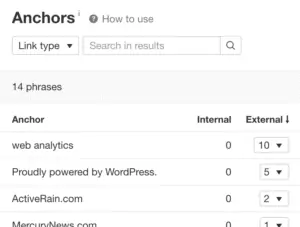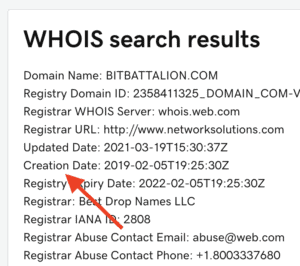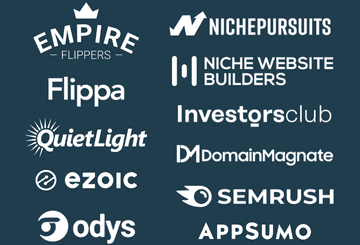The advanced strategy of building a website on an aged or old domain has been around since the early days of Google when marketers first realized that links were a major factor in the ranking algorithm.
Despite this tactic being used by SEOs for many years, it is clear that it still works today if and only if done the right way (no shortcuts). Not only is this demonstrated by numerous examples of aged domains that have grown incredibly fast, but I have also seen great results on my own sites. In fact, I exclusively use aged domains whenever I start a site from scratch.
This guide focuses on:
- Benefits and drawbacks of aged domains
- Where you can buy an aged domain
- Due diligence tips
- Case studies of successful and failed sites built on aged domains
- Common questions
Let’s get into it!
BATTLE-TESTED RECOMMENDATIONS
If you want to learn my tactics in using aged domains to create highly-profitable niche content websites, then this 4+ hour course is what you need.
Digest a decade of experience in a single day with this jam-packed course. I cover how to find aged domains, due diligence, common red flags, teardowns of live domains, case studies of 6-figure sites, and much more more.
Watch the video on Aged Domains
What is an Aged Domain?
An aged domain is a domain name with a history of being used for a live website, typically for a period of several years. An aged domain is typically a domain that had its domain registration expire and was bought at auction by a new owner who intends to rebuild the site.
Difference between Aged Domains vs Expired Domains
An expired domain is a domain name that has not been renewed by the owner within the redemption period and has not been awarded to a new owner by the registrar. The domain goes back to the registry (e.g., Verisign for .com domains) and is eventually re-released by the registry to the public for general registration.
GoDaddy lists domains for auction 26 days after the expiration date and the owner can still renew the domain until 30 days after the expiration date (even if someone bids on the domain at auction).
Aged Domains = Abandoned Real Estate
Aged domains are analogous to abandoned real estate.
Many real estate investors look for such abandoned real estate in good surroundings, buy them, renovate them, and then flip (or rent out). An abandoned property in an amazing area (zip code, neighborhood, city) has tremendous value. Think of the surrounding “area” as the perceived value of authority for that property. Aged domains have backlinks that provide a perceived value of authority to that domain.
For example, a backlink from NY Times (or similar sites) provides immense value to a domain in terms of authority. Similarly, a property within a quick driving/walk distance to a Whole Foods increases property value significantly.
2 Main Benefits of Using Aged Domains for Niche Content Sites
1. Provides a Head Start and Avoids the Google “Sandbox”
An aged domain with powerful links and indexed pages will often provide a good head start over a fresh domain with no links.
A brand new domain can experience the “Google sandbox” effect for around six months where it has very few impressions on the first page of Google search results. An aged domain can skip this sandbox period and sometimes grow to several thousands pageviews in a few short months.
2. Powerful Links That are Expensive or Difficult to Replicate
The most valuable aspect of an aged domain is that it has quality links from niche-relevant websites or highly authoritative publishers like major magazines or news websites. The quality and quantity of links could cost several thousand dollars to replicate.
For example, if you hire a link building service to build links at an average cost of about $100 per link, then it would cost $10,000 to replicate an aged domain with 100 linking root domains. However, you can find aged domains with over 100 linking root domains for around $1,000 on ODYS and it can be much cheaper through GoDaddy Auctions (if you have the time).
The previous owner of an aged domain may have spent thousands of dollars and many hours acquiring or earning links over several years.
4 Potential Drawbacks with Aged Domains
1. Risk of a Google update
Several sites sold on marketplaces like Flippa and Motion Invest were built on aged domains and you can follow the growth or decline of their traffic over time with tools like Ahrefs. In some cases, these sites have suffered a steep decline in traffic during a major Google update.
For example, below is the traffic screenshot of a domain that was obtained by an affiliate marketer and the owner did not match the topic of the original site and published random content. This resulted in a large traffic drop.

Google is well aware of people using aged domains for SEO purposes but Google’s John Mueller says that they are cautious about punishing sites because there are legitimate reasons for using an old domain such as reviving an old site or transferring a site to a new owner.
According to John Mueller, Google looks for instances when “people are trying to abuse the system by picking up domains that are totally unrelated to what they’ve been working on”.
2. There are hidden low quality links
Ahrefs provides an excellent view of the link profile of aged domains including the low quality and spammy links that can hurt your site’s growth potential. If there are a high percentage of links from low quality blogs with thin or duplicate content, this may be a sign of a low quality or unnatural link profile that can hurt your SEO or lead to a manual penalty.
There may also be low quality links that are not shown by Ahrefs because some sites block the Ahrefs bot in their Robots.txt file or its not included in their index for a different reason.
You can overcome this issue by submitting a link disavow file of low quality links to Google. Google generally tries to ignore link spam because it is often out of your control (e.g., a competitor launching a negative SEO campaign and pointing tons of spammy links to your site).
3. Manual penalty was applied by Google
A domain may have received a manual penalty from Google which limits organic traffic and makes it difficult for the site to grow.
The acquirers of Girlfriend.com asked John Mueller why they couldn’t rank for any keywords. It turned out that the previous owner had linked out to a lot of questionable sites and the domain had received a manual penalty from Google.
Three signs that there may be a manual penalty on the domain are:
- The link profile of the domain has an excessive amount of spammy inbound or outbound links.
- The historic organic traffic looks very low in Ahrefs during a time when the site was live.
- There are no pages indexed in Google.
If you acquire a site that received a manual penalty, you can submit a reconsideration request and let Google know that you just acquired the site and have fixed the issues.
4. Site was previously used as a PBN or spammy site
You can check the Ahrefs Outgoing Links Anchors report for the domain to see if there are any outgoing links using spammy anchor text.
If there are links with spammy commercial anchor text, this may indicate that the site was used as a PBN by a previous owner.
A commonly used tactic by PBN builders is to acquire expired domains with a good link profile and then change the links to point to commercial pages (sometimes they try to make the site look exactly the same as before they acquired it).
If you use the “site: search” operator in Google you can sometimes find evidence of unrelated pages (e.g., college paper writing or payday loans) in the description of the Google search result snippets on some of the indexed pages. This indicates that a previous owner has already tried to use the domain to link out to spammy commercial sites which can damage the domain’s reputation.
6 Due Diligence Tips when Buying an Aged Domain
When I buy an aged domain, I follow these due diligence steps. Check it out:
1. Check the actual age of the domain
You can use a Who Is Lookup service like the one provided by GoDaddy or also Who.is to find the creation date of the domain.
Alternatively, you can check Archive.org for the earliest recorded snapshot which would indicate when the domain started publishing content.
2. Check past website history
The best way to learn about the history of a website is to view multiple snapshots from Archive.org (also known as the Internet Archive or Wayback Machine).
Keep in mind that it is possible for a site to look unchanged even if it has been turned into a PBN site with unnatural outbound links to commercial webpages.
If there is a period of time with no snapshots, that probably means the website was not live during that period. It is optimal to minimize the time when the site is down to make it seem like a typical website ownership transfer which should not significantly affect traffic and rankings.
3. Type of backlinks pointing to domain
Ideally, you will want a majority of links to be natural links from relevant authority sites (e.g., Car and Driver for an auto site) and high authority news sites (e.g., New York Times, CNN, Forbes).
It’s a bonus if most of the links are pointing to the homepage because you can direct the link equity more easily to your top pages and you will not have to spend as much time recreating pages (or 301 redirecting them).
Guest post author bio links are less valuable because they are easier to reproduce and Google does not regard these links as highly as natural links within the body of an article. A lot of irrelevant links like scholarship links can also be discounted because they do not help improve topical authority.
Links that look like they were purchased can be an issue because Google may detect this and apply a manual penalty for violating Google Webmaster Guidelines.
4. Verify domain topical relevance with your niche
The main topics covered on the website in the past should be closely related to the niche you plan to publish content about.
Here are some examples of poor vs strong relevancy:
- Poor: A shut-down restaurant domain that now holds content related to kitchen, cooking, home goods
- Good: a shut down website about dog salon now holds content about dog grooming, care, and tips
The goal is to match topical relevancy as best as possible, otherwise, it’s just spam.
5. Check for trademarks
Conducting a proper trademark search is especially important for acquiring older domains because often it was part of an online or brick-and-mortar business in the past.
To do your own check, the first step is to search for the domain name in Google to see if anything similar appears in search results.
Next go to the website for the U.S. Patent and Trademark Office (USPTO)’s Trademark Electronic Search System (TESS). Enter the brand name, similar sounding names, and common alternative spellings to see if there are any matches that raise a red flag.
Doing a quick search can identify any potential trademark issues but this is not a replacement for a professional trademark attorney. You can hire a trademark attorney to do a trademark search for around $250-$400.
6. Check Number of Indexed Pages
When a website goes down for an extended period, the indexed pages will fall out of Google’s index as Google doesn’t want to send searchers to dead pages.
However, a few pages usually remain in the index if the site went down recently or if a bare-bones version of the site was put up by the reseller of the aged domain. If there are a lot of pages remaining in the Google index, this is a good sign that Google still trusts the site.
Where to Buy Aged Domains: Best Aged Domain Marketplaces
I typically acquire aged domains from vetted marketplaces because they save me a ton of time and their domains are brandable and high quality. Check out these marketplaces that I use on a daily basis to source deals:
SerpDomains Review
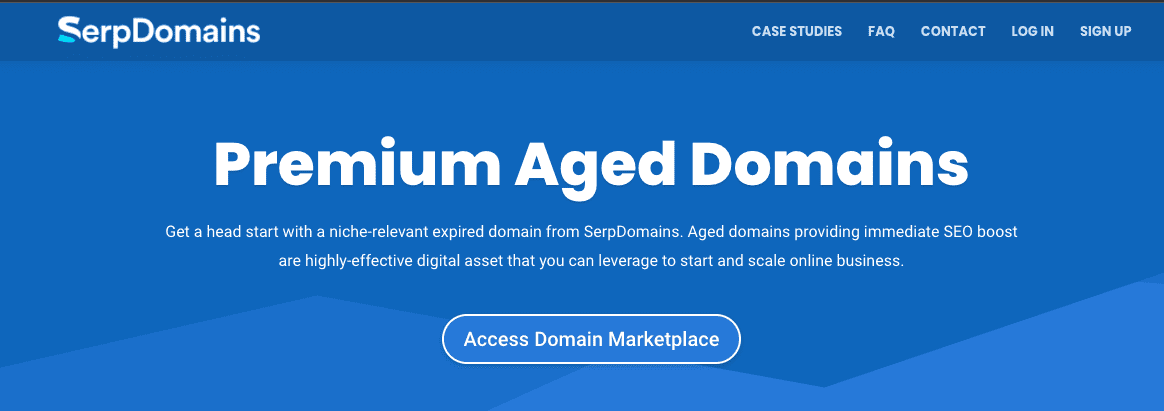
SerpDomains, with a few thousand members, is a marketplace offering and selling premium aged domains perfect for affiliate websites, 301 redirects, and display ad monetized websites. The marketplace is regularly updated with a focus on domain quality in highly profitable niches.
On average, they have over 100+ domains at any given time. Here is a selection of the best:
SerpDomains has excellent Trustpilot reviews and is run by seasoned veterans in the industry.
Odys Review
Odys is a marketplace with over 1,000 aged domains for sale. Odys aims to provide brandable aged domains with a free logo design and prices range from $750 to over $50,000. These are vetted domains with quality backlink profiles. They also host a barebones live version of the website to keep the pages indexed while the domain is available for sale on their marketplace.
Here is a selection of aged domains and their metrics:
SerpNames Review
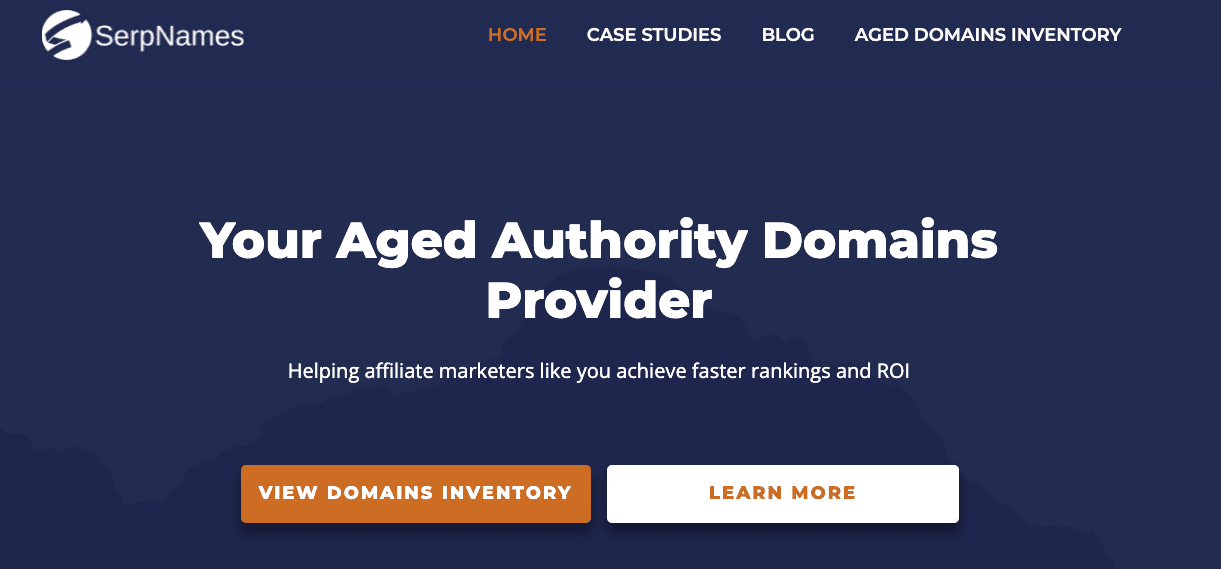
SerpNames.com provides aged domains that help you scale your existing or new website by getting faster rankings & traffic. Their vision is to help affiliate marketers & bloggers grow. The domains they have in inventory are high-quality in excellent niches. I’ve personally bought a few and have had success building them out into niche sites.
They have over 170+ unique domains in their inventory.
Godaddy Auctions Review
If you have the time to search and bid on domains at GoDaddy Auctions, you can acquire great expired domains for a lower price than a reseller marketplace like ODYS.
It costs $4.99 per year for membership to GoDaddy Auctions which allows you to place bids on expired domains. You can enter a maximum bid and the Proxy Bidding Service will automatically increase your bid by $5 each time you are outbid.
Best 3rd-Party Tools to Find Aged Domains: My Recommendations
SpamZilla Review
For $37 per month, SpamZilla allows you to compare metrics on millions of expired domains from all the major third party SEO providers like Moz, Ahrefs, SemRush, Majestic and more. It also pulls in the latest expiring domains from GoDaddy Auctions and other domain providers and these listings can be filtered based on data points like links, auction ending, and price.
They also provide a proprietary spam score that indicates how “clean” the domain is based on data like domain age, redirects, active history, and parked pages.
Spamzilla also provides information on the number of registered owners and how many times the domain dropped. It pulls in snapshot images from Archive.org which helps you review the history of sites at a quick glance.
DomCop Review
DomCop is a similar alternative to SpamZilla which costs $64 per month for the cheapest plan. It provides a table of domains with similar third party SEO data as SpamZilla.
A useful feature of DomCop is that it allows you to filter domains by high number of links, high domain authority, high traffic, and high citation and trust flow.
ExpiredDomains.net Review
ExpiredDomains.net is a popular free tool that allows you to search and filter through expiring and expired domains. It also provides a smaller set of SEO metrics from sources like Majestic and SEMRush, but it provides a lot of data for no cost.

You can quickly sort domains to see domains with the most links, linking domains, links from Wikipedia, traffic, and a number of crawl results in Archive.org, and several other metrics.
This tool provides data on domains from several marketplaces including GoDaddy Auctions and Flippa and you can search the entire database of millions of domains for specific keywords.
3 Case Studies of Successful Sites on Aged Domains
I have done three active case studies of sites built on aged domains. Check out the summary of both below.
1. Dating Informational Site Built on the Aged Domain
My dating site was built on a domain aged since 2007 that the previous owner acquired through GoDaddy Auctions. It had over 1,480 referring domains when I acquired the site in 2019 with many high authority links from major news sites like The New York Times, CNN, The Washington Post, US Government, and more. It currently has nearly 3,000 referring domains.
Since I acquired the site, I have published over 540 informational articles on the site and traffic has increased to about 40,000 per month in the competitive dating niche. The site consistently earns over $10,000 per month from affiliate programs.
Here is the profit and loss chart:
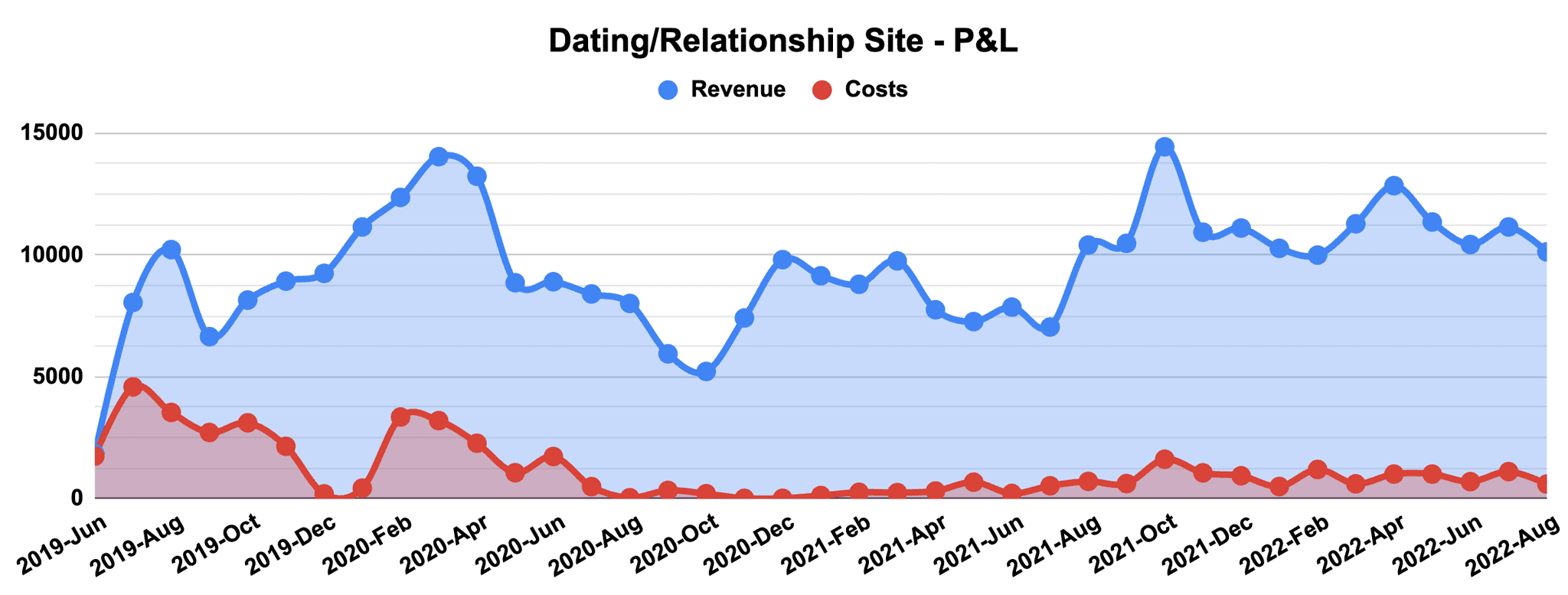
This domain rebuild was successful because of the following reasons:
- The initial batch of 50 articles was a perfect topical relevance match with the previous website
- 301 redirects were set up by first analyzing each old page in Archive.org and then rebuilding the page as close as possible
- The remaining articles were shoulder topics to the original topic and added to the site after 6 months
2. Renewable Energy Site Built on Aged Domain
In December 2019, I acquired an aged domain with the following metrics from ODYS Global:
- AHREFs DR 42
- 201 Referring Domains
- Backlinks from top authority sites like NY Times, Forbes, and niche relevant sites like Energy.gov
- 11 year old domain
The site in the past was an informational blog about renewable energy and policy. To ensure 100% topical relevance, I published content related to solar, wind, other such renewable energy topics.
The site over the course of 14-month since being live has grown month over month. See Google Analytics screenshot below:
The domain has done well since the focus was on adding content that matches the exact topics the site had in the past. Also, I ensured the 301 redirects were set up to the correct pages that matched topical relevance.
3. B2B Site Built on an Aged Domain

In January 2022, I acquired an aged domain in the technology and information niche from the ODYS marketplace for $4,000. The site had 404 referring domains and an AHREFs DR of 31.
I published the first article on January 23rd and immediately started seeing traffic. I published 30 articles on the site in the first month and added an additional 48 articles in the following months (for a total of 78 articles).
I first added monetization with an affiliate program in February and revenue quickly increased in the following months:
- September 2022: $1,890
- October 2022: $1,885
- November 2022: $1,385
- December 2022: $1,820
- January 2023: $1,555
- February 2023: $1,440
- March 2023: $1,700
- April 2023: $2,700
- May 2023: $1,705
- June 2023: $1,560
- July 2023: $1,335
- August 2023: $1,270
Traffic has increased to between 4,000 to 6,000 users per month with the largest traffic source being Bing (about 28%). Only about 5% of the traffic is from Google but the site is still generating strong monthly revenue.
3 Case Studies of Failed Sites On Aged Domains
If not done right or in a spammy way, sites built on old domains can fail.
All of the examples provided had an issue with website history and topical relevance. They built product-based review sites (think Amazon Affiliate sites) on aged domains that were some sort of e-commerce site in the past in the same niche. In my opinion, an e-commerce site turned into a dedicated review site is a red flag.
Furthermore, all of the new site owners placed a large volume of buying guides, and review articles; this is a red flag and there should now be a good mix of information and commercial content on a site.
Check out the examples below. To protect site owners, I kept the URLs hidden.
1. Camera Review Site Built on Old Domain of a Camera Store
An affiliate marketer launched a camera review site in early 2020 on the aged domain of a brick and mortar camera store in Canada that went out of business.
The domain had links from 185 domains including Cannon.ca, a local business directory, and some relevant news articles. The owner published just under 100 product review articles published on the site (very few articles were informational articles).

In November 2020 the site exceeded 20,000 unique visitors and over $1,800 in Amazon affiliate revenue but it was hit by an Google algorithm update in December 2020 and lost over 85% of its traffic and revenue.
2. Cookware Review Site Built on Aged Domain of a Fine Dining Restaurant
A listing for sale on Motion Invest for just over $12,000 was built on an aged domain of a fine dining restaurant that operated from 2007 to 2017.
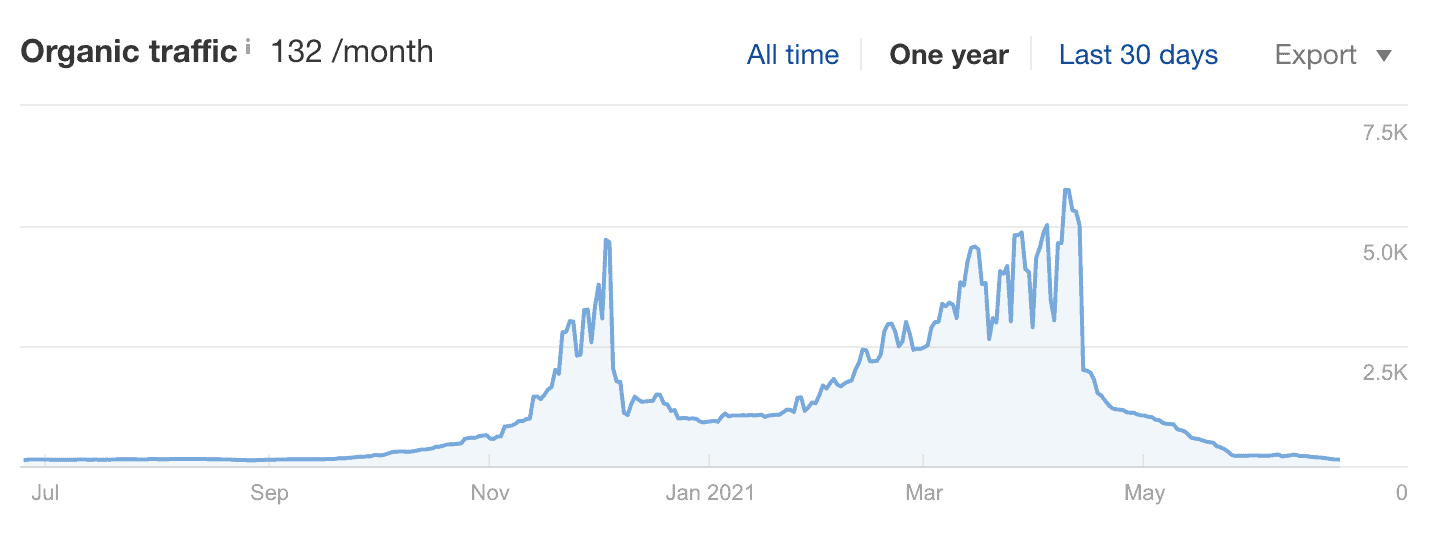
The rebuild started around early 2020 and around 100 cookware product review articles were published on the site. The website peaked at just over 9,000 visitors in February 2021 but organic traffic has declined significantly in April by around 97% according to Ahrefs. Ahrefs estimates that it now gets around 140 organic traffic per month and ranks in the top 3 in Google for just 5 keywords.
3. Wine Cooler Review Site Built on Aged Domain of a Wine Bar
A listing for sale on Motion Invest for just over $90,000 was built on an aged domain of a Toronto restaurant and wine bar that was in business from around 2014 to 2019.
The business was reported to be closing in January of 2020. The new owner started rebuilding the site in the middle of 2020 and by the end of the year it was earning about $5,000 per month from Amazon Affiliates on around 20,000 monthly visitors on just 28 articles published.
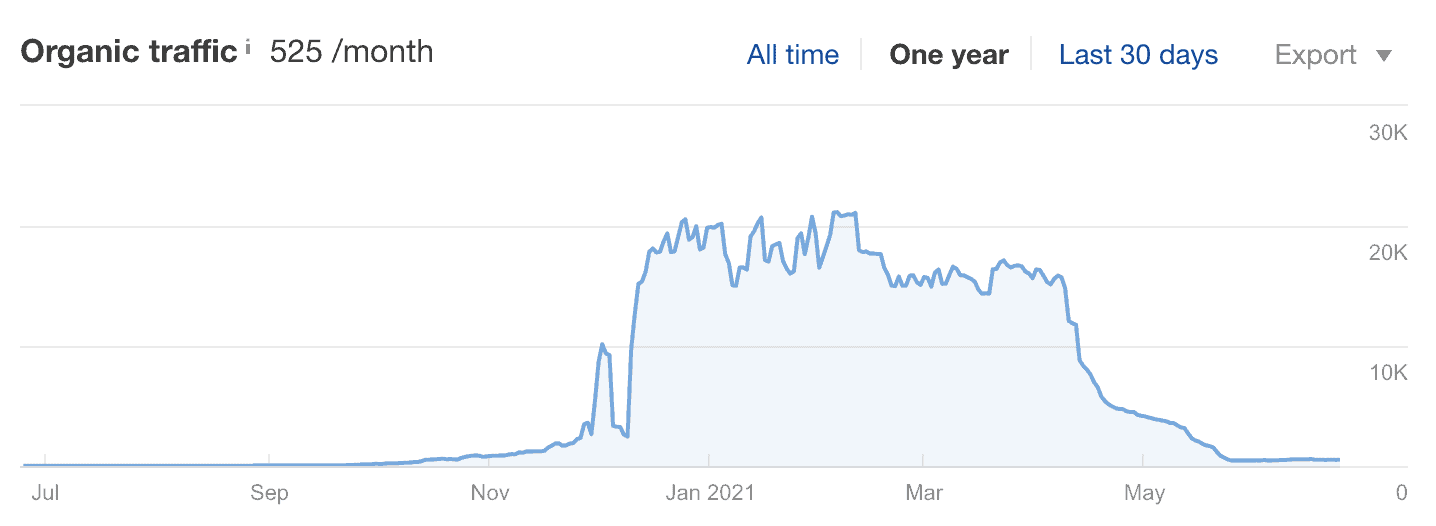
However, according to Ahrefs, organic traffic has been declining rapidly since February of 2021 and is down 98% from its peak. It now gets an estimated 500 monthly visitors and ranks in the top 3 in Google for just 2 keywords.
FAQs about Aged Domains
Do aged domains still work in 2024?
Yes, there are many examples of sites built on aged domains that have grown their traffic rapidly.
For example, the site I built in the B2B niche is now earning $1,772/month over the last 6-month average. This was done in less than a year. Another example is my dating site which was started on an aged domain and consistently earns over $10,000 per month.
If done correctly ensuring topical relevance, then aged domains work extremely well.
How do I know if a domain is aged?
There are two main ways to know if a domain is aged. First, you can use a WHOIS lookup tool (e.g., Who.is) to see when the domain was registered. Second, you can use the Wayback Machine to check the history of the website built on the domain and how it was used.
Are older domains worth more?
Yes, old domains are worth more. There are two reasons for this. First, an older domain may mean a branded domain with a shorter number of characters. Second, an old domain that had a business website on it may have obtained natural quality backlinks over time that increase the worth of the domain.
Are aged domains at higher risk of a Google update or penalty?
Google is cautious about punishing a site that is built on an old or aged domain because it is difficult to know the true intentions of the site owner. However, there are a few cases of sites built on aged domains that quickly lost over 90% of their organic traffic.
Attempting to manipulate the algorithm by building a site about a niche that is unrelated to the content of the previous website is the type of behavior that Google aims to discourage and will usually result in the site taking a hit eventually.
Should I re-use content from the previous website on the domain?
Republishing content from a previous owner without permission may cause legal copyright issues if the previous owner pursues legal action. It is usually best to avoid potential legal issues by creating your own content on the existing URLs that have quality links pointing to them.
Can I redirect an aged domain to an existing site?
Yes, you can redirect an aged domain to an existing site to boost authority of the niche site. You get the benefit of all the backlinks now pointing to pages of your niche site. However, it has its risks since if the age domain has toxic backlinks or is not a topical match, your niche site can be penalized.
For more details, read this article on redirecting aged domains to existing sites.
Is there a difference between aged and old domains?
No. Aged and old domains are the same thing. Old domains are just another way to describe aged domains. Old domains include domains that are typically older than 1 year.
Should I buy aged domains that are cheap?
If you find a quality domain with good branding and it seems cheap compared to others, it most likely has red flags.
The market has matured to a point where good quality domains get multiple bidders at auction. It’s extremely rare to find a domain worth buying that does not have activity.
More bidders participating means the price is going to increase and will no longer be cheap.
Therefore, if you find something relatively cheap, make sure to dig deeper into the domain metrics. Most likely it will have some red flags.
BATTLE-TESTED RECOMMENDATIONS
SerpDomains – #1 Aged Domain Provider
SerpDomains has an AMAZING selection of vetted aged domains that you can use to build your next 6-figure content site. I’ve used SerpDomains to source multiple aged domains for my projects.
Get 15% OFF with code “PREMIUM10” at checkout!
If you want to learn my tactics in using aged domains to create highly-profitable niche content websites, then this 4+ hour course is what you need.
Digest a decade of experience in a single day with this jam-packed course. I cover how to find aged domains, due diligence, common red flags, teardowns of live domains, case studies of 6-figure sites, and much more more.
Wrap Up
Aged domains are a “tool” in my website flipping arsenal. They have a time and place to be used.
When building a niche site on an aged domain, keep these in mind:
- Will your new site’s topic match 1:1 with the old website on the aged domain?
- Are there any low-quality backlinks on the aged domain?
- Is the aged domain indexed?
These are crucial questions to ask yourself before buying an aged domain for your new site.


